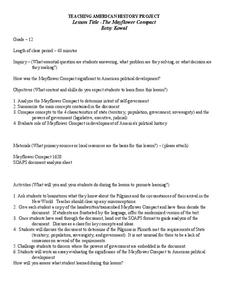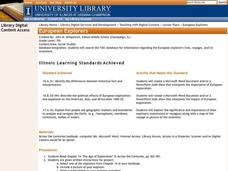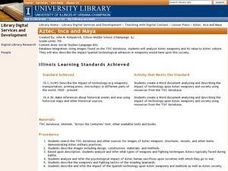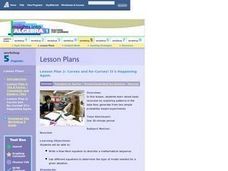Curated OER
If a Picture's Worth a Thousand Words...
Students examine the debate between the preservation of and access to historical artifacts. They explore the notion of ownership and commodification of historical artifacts and come up with a plan for compromise.
Curated OER
The Human Organism
In this digestion and nutrition lesson, 3rd graders test foods to find their vitamin content. Students test for starch and fats then compare their findings on charts and oral reports. The lesson concludes with a teacher directed...
Curated OER
Causes of the American Revolution: the Stamp Act Crisis
Fifth graders view primary documents to become familiar with the causes of the American Revolutionary War. In this Causes of the American Revolution lesson, 5th graders answer questions based on the documents. Students complete a...
Curated OER
Insect Models
Young scholars construct an insect model. In this "insects" science and art lesson, students complete a KWL chart about 'insects," then view several interactive websites to become familiar with insect traits. Young scholars construct an...
Curated OER
Word Roots 2: FIN, SED, FER Beginner Crossword
Learners match definitions to words in order to complete this crossword puzzle. The focus of this puzzle is words that contain the Latin roots FIN, SED, and FER. The answer document does not work, so the vocabulary list off of which this...
Curated OER
Turmoils of The 1960's and 70's.
Students engage in the study of the social problems associated with the 1960's and 1970's. They explain how the government made attempts to solve the problem and evaluate the success. This is done through the writing of an essay using...
Curated OER
Why were the colonists upset about the Stamp Act?
Fifth graders read documents to address why colonists were upset about the Stamp Act. In this sourcing and contextualization lesson, 5th graders read a variety of documents from the American Revolution and predict the author's...
Curated OER
Islamic Art
Students examine the various forms of Islamic Art. Using the art, they identify the basic elements and research its history and style of calligraphy. They create a piece of art based on information they collected and demonstrate...
Curated OER
The Constitution: Drafting a More Perfect Union
Students analyze an unknown primary source document to determine its origin. In this Constitution lesson, students read primary source documents and contrast and compare the evolution of the drafts of the Constitution. Students analyze...
Curated OER
The Mayflower Compact
Twelfth graders discover the ideas of our government by reading the Mayflower Compact. In this U.S. Government activity, 12th graders identify the main ideas of the Mayflower Compact, how it came to be and who was affected the most...
Curated OER
The Odyssey of a Coin
Learners create a fictitious newspaper article to document the travels of an ancient Greek coin. They evaluate the economic conditions that existed in ancient Greece and analyze the impact Alexander the Great had on the ancient world.
Alabama Learning Exchange
Learning About Colonial Life
High schoolers use predictions to explore the lifestyle of American colonists. They draw conclusions about the culture of colonial America based on items used in daily life.
Curated OER
Breaking the Color Barrier: Jackie Robinson's Combat Against Racism
Students explore Jackie Robinson's career. In this 20th century American history lesson, students complete the provided analysis questions based on the provided primary documents about Jackie Robinson. Students discuss Jackie' Robinson's...
Curated OER
The Search for Character!
Fifth graders define character words, look for real-life examples of the traits "in action," and write an acrostic poem based on one of these qualities.
Curated OER
European Explorers
Seventh graders research European Explorers lives. They create a Word Document, or slide show based on their research.
Curated OER
Understanding Federalist #10
Students read the Federalist #10. In groups, they discuss the meaning of each paragraph. Afterward, students write a summary exploring the important arguments of the paper. Students explore the historical significance of the document.
Curated OER
Chairs, Corduroys, Cottages, and Cars: Exploring the Diversity of Design
Students create and present a theme-based exhibition. In this design lesson, students categorize objects to reflect a specific design theme and create their own theme-based collections. Students research a museum collection to discover...
Curated OER
Eleanor Roosevelt and the Universal Declaration of Human Rights
Young scholars explore the leadership of Eleanor Roosevelt through the use of historical documents. They examine the complexity of the creation of international documents. Students explore the Human Rights Declaration.
Curated OER
Trees For Trout!
Fourth graders determine the impact of native forests, local clearcuts and local clearcuts and local reforestation projects on the survivablity of Rainbow Trout in their area. They record and document the stages of the trout throughout...
Curated OER
U.S. Entry Into WWI
Middle schoolers identify the reasons why the United States entered World War I. For this world history lesson, students are given a lecture on Woodrow Wilson and analyze documents (specifically, Woodrow Wilson's speeches). Middle...
Curated OER
Holey Story
Sixth graders create a cloze activity based on an article of a current event. They switch worksheets and the next group chooses the words they feel are missing and justify their word choices.
Curated OER
Aztec, Inca, and Maya
Seventh graders use images of Aztec weaponry to analyze its' value. They create a Word Document with the information.
Curated OER
Examining the Declaration of Independence
Learners examine the Declaration of Independence and its significance to American history. They read the document, identify America's grievances with Great Britain, and restate a part of the document in their own words.
Curated OER
Curses and Re-Curses! It's Happening Again.
Students study basic recursion by exploring patterns in the data they generate from two simple probability-based experiments. In the first, students flip a coin to discover how many times they must flip it before it lands on "heads."...
Other popular searches
- Document Based Questions
- Document Based Essays
- Document Based Essay Women
- Document Based Question Wwi
- Document Based Questions Essay
- Government Document Based























